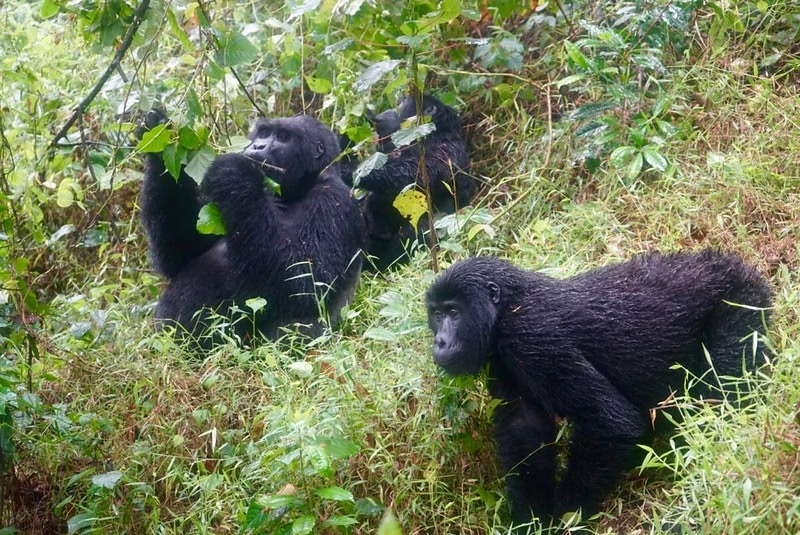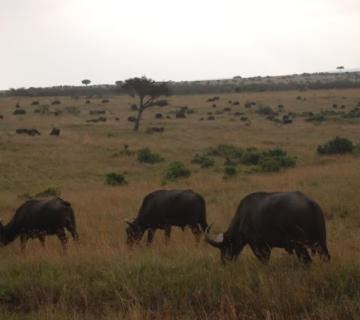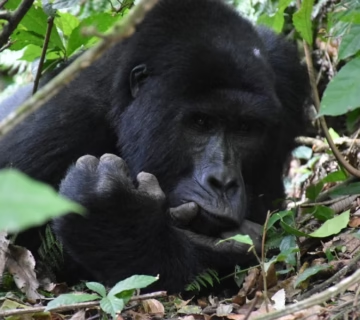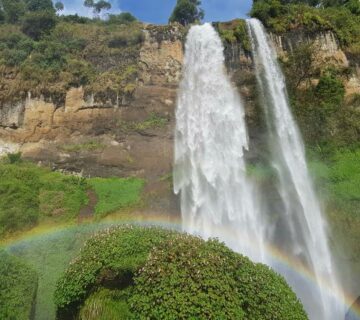How difficult is gorilla trekking?
How difficult is hiking for gorillas? Is hiking with gorillas difficult? Will I be able to hike with gorillas? One of the first things that comes to mind for every traveler after an African gorilla safari is how challenging gorilla trekking is. They question if they will really be able to overcome the dense forests that the gorillas call home.
Only located in sub-Saharan Africa, gorillas are incredible primates. Gorillas inhabit hilly and forested regions in many African nations. The pastime known as “gorilla trekking” involves hikers traversing these forests in pursuit of gorillas in their natural environment. The mountain gorillas are the most well-known and sought-after gorilla species.
Only three African nations—Uganda, Rwanda, and the Democratic Republic of the Congo—are home to the endangered mountain gorilla species. As their name implies, mountain gorillas live in the mountainous regions of gorilla destinations, often in high-elevation regions with dense rainforest vegetation.
The Bwindi Impenetrable National Park in Uganda, the Virunga Massifs, which include the Mgahinga Gorilla National Park in Uganda, the Virunga National Park in the Congo, and the Volcanoes National Park in Rwanda, are home to mountain gorillas.
With only about 1000 mountain gorillas remaining in the world, Bwindi Impenetrable National Park is the gorilla destination with the largest gorilla population; more than half of the world’s gorilla population is found in Uganda’s Bwindi Impenetrable National Park. In order to find gorillas in their native habitat—which is teeming with other species, flora, and fauna that captivates visitors—gorilla trekking, particularly mountain gorilla trekking, entails traveling through these lush tropical rainforests.
How difficult is hiking for gorillas? In order to gauge how challenging gorilla trekking is for you, many criteria must be taken into account. These include:
Time frame
The length of time spent gorilla trekking is a crucial consideration. Travelers usually have the opportunity to hike until they truly get a chance to interact with the gorillas. In Uganda, gorilla trekking may last anything from thirty minutes to six hours or more. For a variety of reasons, including to find food and a place to nest, gorillas are always on the go.
Since they are always moving, gorilla trekking may be rather unexpected due to the need to follow the gorilla trails. Even while it could just take 30 minutes or less to locate the gorillas, it is as conceivable to spend six hours or more in order to see them.
No matter how long it takes to locate the gorillas, you will be astounded by their breathtaking beauty as soon as you see them in their natural environment. Jet black blackbacks, adult females, babies, and young gorillas will all be visible to you, along with the silverback, the family’s leader. The time it takes to locate the gorillas, however how challenging it may be, will all be rewarded when you finally see them.
After you locate the gorillas, you will spend an hour admiring their beauty and majesty. It is advisable that travelers spend some time to prepare for the gorilla trekking so that they are at least somewhat fit to handle the long hours of trekking the gorillas, since the time required to reach them may be taxing.
It’s also a good idea to hire a porter to help you carry your bags so that you have the energy to finish the gorilla trek. For travelers who are too old, disabled, or unfit to do the gorilla trek, sedan chairs can be reserved for them, and several people will carry them the entire way.
Terrain and altitude
As their name implies, mountain gorillas live in the hilly regions of the rainforests they call home. Given the steep, rocky, and densely forested landscape of Bwindi Impenetrable National Park, it is no surprise that the park is known as “impenetrable.” In order to reach the gorillas, your guide will assist you in navigating different types of terrain and clearing foliage.
However, this is insufficient, and in order to navigate the increasingly difficult terrain and high elevations, travelers are advised to be physically and psychologically prepared for the gorilla trip.
It is also recommended that travelers wear good hiking shoes since the walk might be challenging and slick.
The weather
In the jungles where mountain gorillas live, the weather may be erratic at times. Rainfall can occur during the “dry season,” while during the supposedly wet season, the sun may shine for hours on end. The dry season is the ideal time of year to go gorilla trekking since the park’s roads, walkways, and trails are more livable.
Given that the mountain gorilla parks are tropical rainforests, it is nevertheless recommended to bring a rain jacket or poncho since it may still rain. Gorilla trekking permits sell out quickly during the dry season, which runs from June to September and December to February. This is also the busiest travel period. It is strongly advised to reserve gorilla trekking permits at least three months before to the trip date.
The rainy season, which occurs throughout the other months of the year, may make it more difficult to trek gorillas since the roads and pathways are muddy and slick, and the forest is so overgrown that it can be difficult to detect them and take images of them. However, it doesn’t always rain; sometimes, it only does so in the afternoons and evenings, allowing visitors to take advantage of the early hours to go gorilla trekking.
Gorilla trekking is possible all year round, regardless of the season, weather, or current environment. You will conquer and enjoy your experience with the gorillas if you prepare yourself both emotionally and physically for the gorilla trekking trip.
Unusual behaviors of gorillas
Gorillas are untamed creatures that inhabit the wild. The gorillas that tourists do come across on gorilla trekking excursions are habituated, having spent around two years acclimating to human presence and contact by knowledgeable gorilla specialists. Gorillas are capable of becoming protective when provoked, regardless of their level of habituatedness.
In some cases, gorillas have charged at visitors or park rangers. Although gorillas are friendly creatures, there are some guidelines for gorilla trekking that travelers are advised to follow in order to prevent such situations. It is recommended that travelers stick to the dos and don’ts, pay close attention to all directions, and always obey their guide.
However, while gorilla trekking, you are accompanied by armed park rangers who will always keep you safe. Even if the gorillas charge at you, these park guards and guides are well-trained to handle any circumstance. Always make sure you follow their directions.
The price of permits for gorilla trekking
Based on the price of gorilla trekking permits, some tourists could evaluate the degree of difficulty of gorilla trekking. Permits for gorilla hiking differ according on the location. For instance, a single gorilla trekking permit in Rwanda costs $1500 per person each trip, but Congo gorilla trekking licenses are $400. Gorilla hiking licenses in Uganda are $300,000 for East African nationals, $700 for international residents, and $800 for foreign non-residents.
A traveler’s budget may be impacted by the cost of gorilla trekking permits, which might raise the price of a gorilla trekking safari. It is recommended that travelers choose the option that best suits their gorilla trekking safari.
Before starting a gorilla trekking expedition, there are many variables to take into account, such as financial, physical, and mental preparation. But at the end, you will have incredible recollections of your time spent with the gorillas in their natural environment.
You may be thinking, “How hard is gorilla trekking?” It’s not that hard; all you need to do is psychologically, physically, and financially prepare yourself so that you may enjoy your most anticipated gorilla trekking safari.



